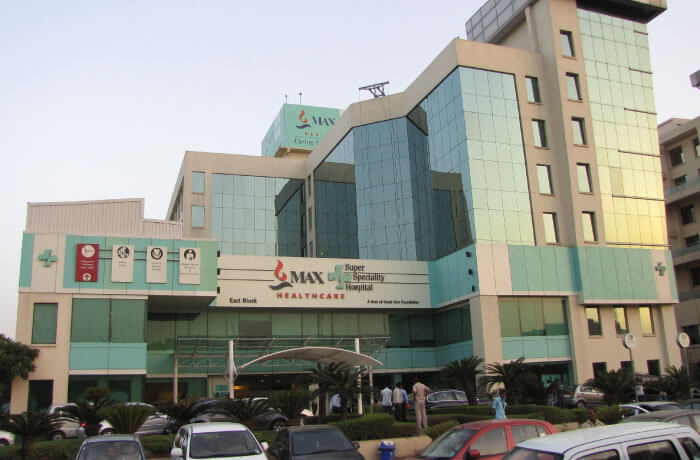Orthopaedic
Total Hip Replacement Surgery
Total Hip Replacement
In a total hip replacement (also called total hip arthroplasty), the damaged bone and cartilage is removed and replaced with prosthetic components. The damaged femoral head is removed and replaced with a metal stem that is placed into the hollow center of the femur.
What is Total Hip Replacement Surgery?
Total Hip replacement surgery is a procedure in which a doctor surgically removes a hip joint which has been damaged by arthritis, a fracture, or other conditions and replaces it with an artificial joint, known as a prosthesis. The artificial joint is often made from metal and plastic components. It is usually performed when all other treatment options have failed to provide adequate pain relief. The procedure should relieve a painful hip joint and makes walking easier.
Hip replacement surgery is usually necessary when the hip joint is worn or damaged to the extent that the joint’s mobility is reduced and the patient experience pain even while resting. The hip may be so stiff that it may be hard to put on shoes and socks, and activities, like walking or getting in and out of a chair, may become painful and difficult.
What is the difference between hip and total hip replacement surgery?
Total Hip Replacement (THR)
Also known as Total Hip Arthroplasty
What's replaced?
The whole hip joint:
- The femoral head (the ball on the end of the thigh bone)
- The acetabulum (the socket in the pelvis)
Implants used:
- A metal or ceramic ball on a stem (fit into the thigh bone)
- A metal socket, usually with a plastic or ceramic liner
This is the most frequently used one and is done due to bad arthritis or damage to the joint.
Partial Hip Replacement (Hemiarthroplasty)
Also simply referred to as Hip Replacement in certain situations
What's replaced?
- The femoral head (ball) only
- The socket (acetabulum) is not touched
Implants utilized:
-
The ball and ball stem only are replaced
Usually performed for hip fractures in older people, but not for arthritis.
Cause of Total Hip Replacement
The most common source of chronic hip pain and disability is arthritis. Osteoarthritis, rheumatoid arthritis, and traumatic arthritis are the most usual forms of this disease.
- Osteoarthritis: Osteoarthritis is an age-related type of arthritis. It usually occurs in people who are 50 or older and often in individuals with a family history of arthritis. The cartilage cushioning the bones of the hip wears away with the age. The bones then rub against each other, which results in pain and stiffness. Osteoarthritis may also be caused or accelerated by subtle irregularities in how the hip develops in the childhood.
- Rheumatoid arthritis: Rheumatoid arthritis is an autoimmune disease in which the synovial membrane becomes inflamed and thickened. This chronic inflammation can damage the cartilage, resulting in pain and stiffness. Rheumatoid arthritis is the most common type of a group of disorder which is termed as "inflammatory arthritis."
- Post-traumatic arthritis: Post-traumatic arthritis can be followed by a serious hip injury or fracture. The cartilage may become damaged and lead to hip pain and stiffness over time as a result of Post-traumatic arthritis.
- Avascular necrosis: An injury to the hip, such as a dislocation or fracture, these may restrict the blood supply to the femoral head, this is called avascular. The lack of blood may cause the surface of the bone to collapse, and results in arthritis. Some diseases can also result in avascular necrosis.
- Childhood hip disease: Some infants and children have hip problems from their birth, even though the problems are successfully treated during childhood, they may still cause arthritis later on in life. This may happen because the hip is not able to grow normally, and thus the joint surfaces are affected.
Total Hip Replacement Surgery Procedure
Hip replacement surgery can be done traditionally or by using what is consi dered a minimally invasive technique. The main difference between the two procedures is the size of the incision (cut).
dered a minimally invasive technique. The main difference between the two procedures is the size of the incision (cut).
During standard hip replacement surgery, patients are generally given anesthesia to relax their muscles and put them into a temporary deep sleep. This will prevent them from feeling any pain during the surgery or have any awareness of the procedure. A spinal anesthetic may also be given to help prevent pain.
The doctor will make a cut along the side of the hip and move the muscles connected to the top of the thighbone by exposing the hip joint. After this, the ball portion of the joint is removed by cutting the thighbone with a saw. Then an artificial joint is attached to the thighbone either using cement or a special material that allows the remaining bone to attach to the new joint.
The doctor then prepares the surface of the hipbone by removing any damaged cartilage and then the replacement socket part is being attached to the hipbone. The new ball part of the thighbone is being inserted into the socket part of the hip. The incision is being closed and the muscles are being reattached by the doctor.
While most hip replacement surgeries today are being performed using the standard technique, in recent years, the minimally-invasive technique is more followed by the doctor. In the minimally-invasive technique, doctors make one to two cuts which are 2 to 5 inches long. The same procedure is done through these small cuts as with standard hip replacement surgery.
The small cut helps in less blood loss, eases the pain, shortens hospital stays, reduces scar appearance, and speed up healing.
Research has proven the outcomes with minimally-invasive approach may be worse than with standard hip replacement surgery if done by a doctor who is not very experienced with this technique, so it's important that the surgeon be highly skilled in this technique.
Total Hip Replacement Surgery Recovery
The success of the surgery will largely depend on how well the patient follows his/her orthopedic surgeon's instructions regarding home care during the first few weeks after surgery.
Wound Care
The patient may have stitches or staples running along the wound or a suture beneath the skin. The stitches or staples may be removed 2 weeks after the surgery.
The wound must not get wet until it has been thoroughly sealed and dried. The wound must be bandaged to prevent irritation from clothing or support stockings. Diet Loss of appetite is common for some weeks after surgery. A balanced diet, complemented with an iron supplement, is important to promote proper tissue healing and to restore muscle strength. Fluids must be drunk in vast quantity.
Activity
Exercise is a crucial component of home care, particularly after the first few weeks of the surgery. The patient should be able to resume most of the normal light activities of daily living within 3 to 6 weeks after the surgery. Some discomfort with normal activities is common for several weeks after the surgery.
The activity program must include:
- A graduated walking program to slowly increase the mobility, initially in one’s home and later outside
- Resuming household activities, such as sitting, standing, and climbing stairs
- Specific exercises several times a day for restoring the movement and strengthening the hip. The patient might be able to perform the exercises without any help; he/she must take help of a physical therapist to help them at or in a therapy center especially for the first few weeks after surgery.
Medical progress in the field of surgical orthopedics, especially joint replacement surgeries, has been extremely rapid in the recent few decades. Over the past few years, there has been an exponential rise in the number of hip replacement surgeries conducted in India.
About Total Hip Joint Replacement Surgery
- Hip replacement surgery is also called total hip arthroplasty.
- Your hip joint may need to have damaged pieces surgically removed and replaced with ceramic, metal, or hard plastic components.
- The hip joint is composed of a socket (in the pelvis) and a ball (at the head of the femur).
- During this treatment, one or both hip components are replaced.
- This prosthetic joint aids in improving function and reducing pain or discomfort.
- If your hip discomfort is preventing you from carrying out your daily activities and your nonsurgical therapies are no longer working, this might be the best course of action for you.
- One of the most common reasons for hip replacement surgery is the progression of arthritis.
Types of Hip Replacement Operation in India
Hip replacement surgery can be divided into three main categories:
- Total hip surgery
- Partial hip replacement
- Hip resurfacing
Total hip replacement
- This is the most popular kind of surgery performed when everyday activities become difficult due to severe arthritis or injury-related damage.
- Prostheses are used to replace the acetabulum and femoral head during the surgery.
- To secure the acetabular prosthesis, your surgeon will first dislocate the femoral head from the acetabulum, remove any damaged cartilage, and rebuild the socket.
Partial hip replacement
- It is not advised for patients with rheumatoid arthritis or osteoarthritis to have partial hip replacement surgery.
- It is helpful in situations where only one side of the hip needs to be replaced.
- Elderly patients who have had a severe fall and fractures to their neck or femur typically want to have only one side of their injured hip joint replaced rather than both can benefit from this.
Hip resurfacing
- To save some of the proximal femoral bone, the doctors would remove the upper outer section of the femoral socket and replace it with a metal cap, leaving the socket intact.
- For younger people who want a greater range of motion, it can be a possibility.
Revision hip replacement
- This procedure is typically carried out to replace a failing hip replacement that now needs the old parts to be removed and replaced with new ones.
Conditions requiring Total Hip Surgery
Hip replacement surgery may be necessary if certain conditions result in damage to the hip joint. The following are a few of the conditions:
Osteonecrosis: This disease results from a fracture or dislocation. The hip joint's ball area may experience considerable discomfort if there is insufficient blood flow, resulting in the collapse and distortion of the bone.
Rheumatoid arthritis: It is a form of inflammation brought on by an overactive immune system that damages and deforms joints by eroding cartilage and, in certain circumstances, underlying bone.
Osteoarthritis: It damages the slippery cartilage that covers the ends of bones and permits unrestricted movement of joints; it is sometimes referred to as wear-and-tear arthritis.
If you feel any of the following types of discomfort, we recommend a hip replacement:
- Your pain makes it difficult to walk, even with a walker
- Pain gets worse when you get up from a seated position
- Affects your ability to climb stairs
- Impairs your ability to sleep
Benefits of Total Hip Joint Replacement Surgery in India
India provides foreign patients with a plethora of benefits related to hip replacements:
Expertise:
- With their extensive experience in the field, India's team of specialists provides the best Hip Joint Replacement Surgery.
- At every stage of the procedure, the highly competent Joint Replacement surgeons accomplish precision and elegance using cutting-edge technology.
Cutting-edge Infrastructure
- India is experiencing a boom in medical tourism, in part due to the country's investment in state-of-the-art machinery and availability of cutting-edge technologies for increased precision and safety.
Economical Therapies
Compared to other nations providing treatments of the same caliber, India offers hip replacement surgery for more than half the price. This even covers the price of lodging and transportation.
All-inclusive Services
- International patients can receive comprehensive care from numerous healthcare facilities that perform hip replacement surgery.
- International patients may unwind and concentrate on their treatment, from their first consultation to travel and lodging arrangements and language services.
Success rates of Total Hip Implant in India
The following are some crucial details regarding the success rate of hip replacements in India:
- For up to 15 years, the implants usually continue to work properly in all age groups and situations.
- Hip replacement procedures have a 90% to 99% success rate and are generally safe.
- Approximately 90–95% of patients have success after ten years after surgery.
- After 20 years after hip replacement surgery, the success rates rise to 80–85%.
- Because of the availability of cutting-edge technologies, specially made implants, and highly qualified surgical teams, India has an exceptional healthcare system that can provide you with better results and an enhanced quality of life following this treatment.
Recovery process after Total Hip Transplant Surgery in India
- Your healing process is supervised by a surgeon, physical therapist, or occupational therapist who also arranges for exercises and medication to enhance the results.
- After surgery, it's critical to.
- Follow the doctor's instructions and keep the surgery site dry and clean.
- Take medicine to avoid getting sick or forming blood clots.
- Engage in physical treatment as well as at-home workouts.
- To lessen swelling, elevate the leg and apply ice.
Best Hospitals offering Total Hip Transplant Surgery in India
- Fortis Memorial Research Institute - Gurugram
- Medanta The Medicity - Gurugram
- Artemis Hospital - Gurugram
- Marengo Hospital - Gurugram
- Fortis Flt Lt Rajan Dhall Hospital- Vasant Kunj, New Delhi
- Max Hospital - Delhi
- Apollo Hospital - Delhi
Best surgeons for Total Hip Replacement in India
- Dr. Subhash Jangid
- Dr. Jayant Arora
- Dr. Ashok Rajgopal
- Dr. Raman Kant Aggarwal
- Dr. I P S Oberoi
- Dr. Ramkinkar Jha
- Dr. Hemant Sharma
- Dr. Rajesh Kumar Verma
- Dr. Manoj Miglani
- Dr. Gurinder Bedi
- Dr. S K S Marya
- Dr. Vikas Gupta
- Dr. Amit kumar Agarwal
- Dr. Masood Habib
Why African Patients choose GetWellGo for Total Hip Transplant Surgery in India?
GetWellGo is regarded as a leading supplier of healthcare services. We help our foreign clients choose the best treatment locations that suit their needs both financially and medically.
We offer:
- Complete transparency
- Fair costs
- 24 hour availability
- Medical E-visas
- Online consultation from recognized Indian experts
- Assistance in selecting India's top hospitals for hip surgery.
- Expert physicians with a strong track record of success
- Assistance during and after the course of treatment
- Language Support
- Travel and Accommodation Services
- Case manager assigned to every patient to provide seamless support in and out of the hospital like appointment booking
- Local SIM Cards
- Currency Exchange
- Arranging Patient’s local food
FAQ
1. What is the duration of hip replacement surgery?
- A hip replacement procedure may require two to three hours. However, this typically depends on the kind of operation carried out.
2. How much time does recovery from a hip replacement take?
- Following a hip replacement, recovery may take two to three months. However, this varies according to each patient's condition. Younger individuals typically heal more quickly.
3. How can I apply for, obtain, or schedule a hip transplant in India?
- We can assist you in finding the top hip transplant hospital in India.
To schedule an appointment for hip transplant in India,contact us via phone at +91-9289678787 or email us at care@getwellgo.com
TREATMENT-RELATED QUESTIONS
GetWellGo will provide you end-to-end guidance and assistance and that will include finding relevant and the best doctors for you in India.
A relationship manager from GetWellGo will be assigned to you who will prepare your case, share with multiple doctors and hospitals and get back to you with a treatment plan, cost of treatment and other useful information. The relationship manager will take care of all details related to your visit and successful return & recovery.
Yes, if you wish GetWellGo can assist you in getting your appointments fixed with multiple doctors and hospitals, which will assist you in getting the second opinion and will help you in cost comparison as well.
Yes, our professional medical team will help you in getting the estimated cost for the treatment. The cost as you may be aware depends on the medical condition, the choice of treatment, the type of room opted for etc. All your medical history and essential treatment details would be analyzed by the team of experts in the hospitals. They will also provide you with the various types of rooms/accommodation packages available and you have to make the selection. Charges are likely to vary by the type of room you take.
You have to check with your health insurance provider for the details.
The price that you get from GetWellGo is directly from the hospital, it is also discounted and lowest possible in most cases. We help you in getting the best price possible.
No, we don't charge patients for any service or convenience fee. All healthcare services GetWellGo provide are free of cost.
Top Doctors for Orthopaedic
Top Hospitals for Orthopaedic
Contact Us Now!
Fill the form below to get in touch with our experts.



.jpg)



